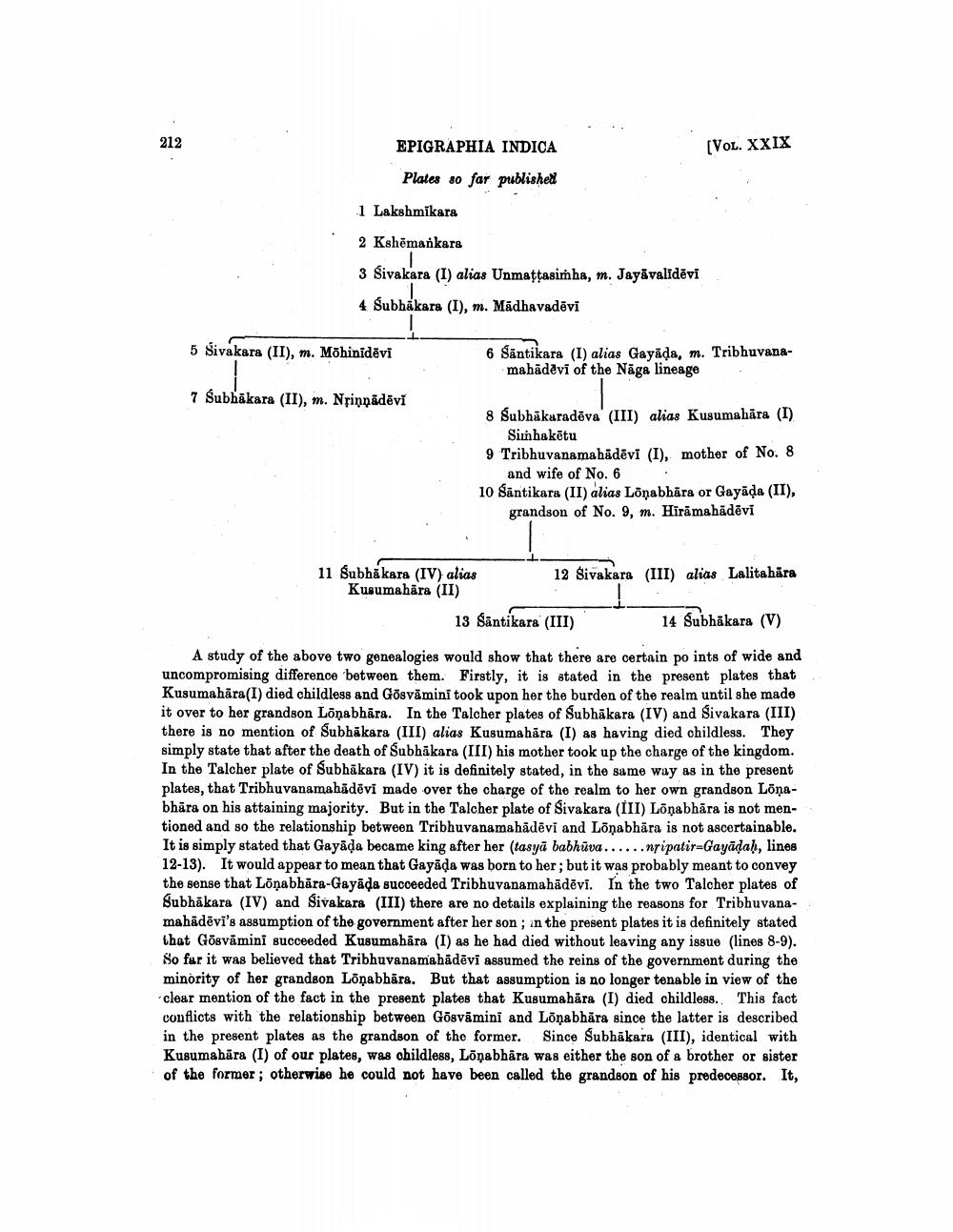________________
(VOL. XXIX
EPIGRAPHIA INDICA Plates so far published
1 Lakshmikara
2 Kshēmankara 3 Sivakara (I) alias Unmaţtasimha, m. Jayāvalidēvi 4 Subhákara (I), m. Madhavadēvi
5 Sivakara (II), m. Māhinidēvi
6 Säntikara (I) alias Gayāda, m. Tribhuvana
mahādevi of the Näga lineage
7 Subhākara (II), m. Nrinnādēvi
8 Subhākaradēva (III) alias Kusumahāra (I)
Sinhakētu 9 Tribhuvanamahādēvi (I), mother of No. 8
and wife of No. 6 10 Santikara (II) alias Lönabhära or Gayāda (II),
grandson of No. 9, m. Hiramahädēvi
11 Subhākara (IV) alias 12 Sivakara (III) alias Lalitabāra Kusumahāra (II)
13 Šāntikara (III) 14 Subhākara (V)
A study of the above two genealogies would show that there are certain points of wide and uncompromising difference between them. Firstly, it is stated in the present plates that Kusumahāra(I) died childless and Gõgvåmini took upon her the burden of the realm until she made it over to her grandson Lõnabhāra. In the Talcher plates of Subhākara (IV) and Sivakara (III) there is no mention of Subhākara (III) alias Kusumahāra (I) as having died childless. They simply state that after the death of Subhākara (III) his mother took up the charge of the kingdom. In the Talcher plate of Subhākara (IV) it is definitely stated, in the same way as in the present plates, that Tribhuvanamahādēvi made over the charge of the realm to her own grandson Lõnabhara on his attaining majority. But in the Talcher plate of Sivakara (III) Lõnabhāra is not mentioned and so the relationship between Tribhuvanamahādēvi and Lõnabhāra is not ascertainable. It is simply stated that Gayāda became king after her (tasyā babhūva......npipatir=Gayādah, lines 12-13). It would appear to mean that Gayāda was born to her; but it was probably meant to convey the sense that Lõnabhära-Gayāda succeeded Tribhuvanamahādēvi. In the two Talcher plates of Subhākara (IV) and Sivakara (III) there are no details explaining the reasons for Tribhuvanamahādēvi's assumption of the government after her son ; in the present plates it is definitely stated that Gögvāmini succeeded Kusumahāra (I) as he had died without leaving any issue (lines 8-9). So far it was believed that Tribhuvanamahādēvi assumed the reins of the government during the minority of her grandson Lõnabhāra. But that assumption is no longer tenable in view of the clear mention of the fact in the present plates that Kusumahåra (I) died childless. This fact conflicts with the relationship between Gösvāmini and Lönabhåra since the latter is described in the present plates as the grandson of the former. Since Subhakara (III), identical with Kusumahāra (I) of our plates, was childless, Lõnabhāra was either the son of a brother or sister of the former; otherwise he could not have been called the grandson of his predecessor. It,




